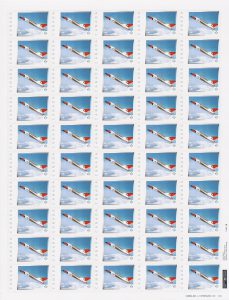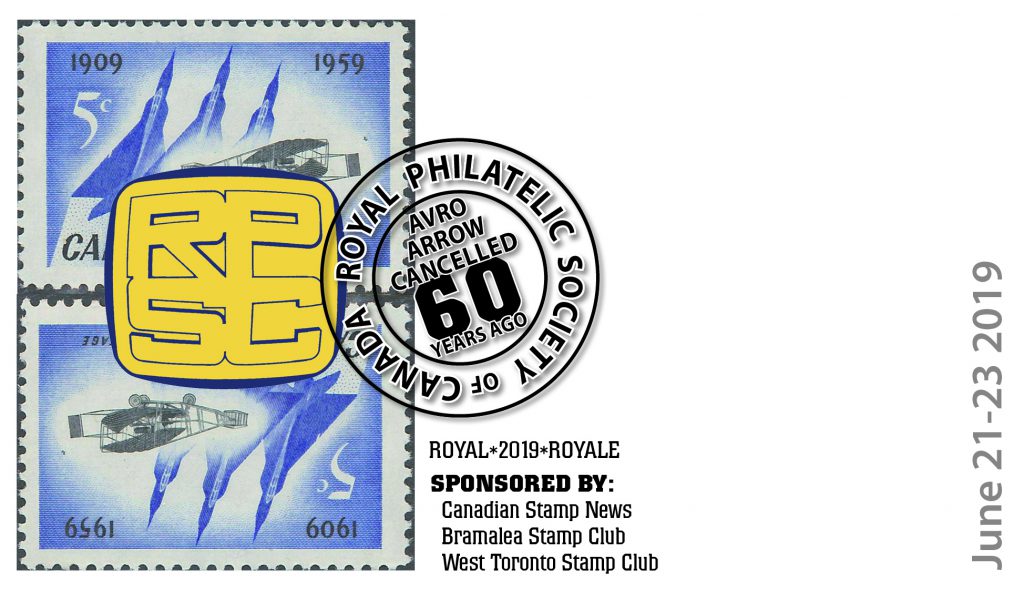The 60th anniversary of the cancellation of the Avro Arrow is marked on the show cover for this year’s Royal Philatelic Society of Canada (RPSC) Convention, which is coming to Mississauga in just over a week.
On Feb. 20, 1959, prime minister John Diefenbaker announced the termination of A.V. Roe Canada’s Arrow, then the world’s most advanced military aircraft.
A wholly owned Canadian branch of the U.K.-based Hawker Siddeley Group’s A.V. Roe and Company, A.V. Roe Canada – or Avro Canada – launched in 1945 out of an aircraft plant in Malton, Ont.
Throughout the second half of the 1940s, Avro Canada began supplying the Royal Canadian Air Force (RCAF) with the CF-100 Canuck, the first Canadian-built military fighter aircraft, and began work on its C102 Jetliner prototype, which became the second jet airliner to fly – only 13 days after the de Havilland Comet – in 1949.
In the 1950s, now tasked with creating a new state-of-the-art jet for the RCAF, Avro Canada began work on its Arrow, which would weigh about 20,000 kilograms with a 15.2-metre wingspan.
After extensive and intensive testing using wind tunnels and one-eighth scale models, the first Arrow was unveiled in front of 12,000 people at the Malton plant on Oct. 4, 1957. It was little more than two years after the first Arrow drawings were produced and the same day as the Soviet Union’s launch of the world’s first artificial satellite, Sputnik I.
Polish test pilot Jan Zurakowski, who fought in the Battle of Britain, became the first person to fly an Arrow on March 25, 1958. This inaugural flight used borrowed engines as the company was still working on its “Iroquois” engines, but the tests were deemed a success.
“It was said to be everything that they had hoped it would be,” Davide Montebruno, curator assistant at the Royal Aviation Museum of Western Canada, told CBC News in March 2018, “It was extremely fast and extremely effective, theoretically, at what it was built to do. Obviously, it never got a chance to do those things, except in the tests.”
After the March 1958 inaugural flight, the five “Mark 1” Arrow aircraft flew nearly 70 times, but the more powerful “Mark 2” aircraft – still in development – never took to the skies.
By 1958, Avro Canada had become Canada’s third-largest company by earnings and employed more than 50,000 people in aircraft and aero-engine manufacturing as well as coal mining, steel making, railway rolling stock plus computers and electronics.
The Arrow was, as journalist David Wilson wrote, “form sublimely married to function” as it travelled nearly twice the speed of sound at an altitude of more than 16 kilometres using the world’s first computerized flight control and weapons system.
But it was this groundbreaking weapons system which proved to be the downfall of the project, the costs of which exceeded $1.1 billion; however, there were also concerns about the technology being outdated following the launch of Sputnik I and rise of intercontinental ballistic missiles (ICBMs).

A personalized Picture Postage stamp depicting the Avro Arrow will also be affixed to this year’s show cover, which is available for $5 each or three for $10.
1957 GENERAL ELECTION, 1959 CANCELLATION
In June 1957, Progressive Conservative leader John Diefenbaker was elected as Canada’s prime minister with a minority government.
Focused on decreasing federal spending after more than two decades of federal Liberal rule, Diefenbaker took aim at the growing costs of the Arrow project and was reported to have a sour relationship with Avro Canada’s president Crawford Gordon Jr.
“There is no purpose in manufacturing horse collars when horses no longer exist,” said Diefenbaker on March 3, 1958, upon learning the British military had deemed interceptor aircraft obsolete.
Later that year, Diefenbaker granted a hearing to Gordon, who was reported by an aid to be “incoherent, like a person demented,” demanding the aviation program be continued; however, the following February, the prime minister announced the program’s cancellation before the House of Commons.
About 14,000 highly skilled workers lost their jobs overnight – a day since known as “Black Friday” in the aviation industry – and by July 1959, all eight prototypes were destroyed (only one nose section survives).
“Notice of termination,” announced Gordon on the company’s loudspeaker after hearing of Diefenbaker’s decision. “There will be no work for you.”
Dennis McDermott, then a full-time organizer for the United Auto Workers in Canada union, predicted the country “would now lose the cream of our skilled aircraft technicians to the United States. History will prove this to be one of the most colossal blunders made by a prime minister in the history of Canada.”
By the time of Avro Canada’s dissolution in 1962, job losses exceeded 25,000; however, Diefenbaker stood by his decision to cancel the Arrow.
“When one’s faced with a problem like this, there is a higher source of strength. If one doesn’t have that … he can never bear the attacks made on him,” he told CBC News.
“I knew that a great industry that had been established would be weakened. But it was right to end it.”
Despite the short-term impacts of the Arrow’s cancellation and the company ending its operations in Canada, the long-term impacts on Canadian aviation and science are debatable.
The former Canadian company Spar Aerospace, which worked on research for the Arrow project, build the robotic arm known as “Canadarm” for the Space Shuttle program.
Today, the Canadian aerospace industry is estimated to contribute about $25 billion in gross domestic product plus 190,000 jobs.
“Well, I think we still can recognize that the Canadian air industry, despite this loss, is very, very strong,” Montebruno told CBC News. “Its legacy is in knowing that we’re capable of these things, that we have this skill, this experience in Canada.”
ROYAL*2019*ROYALE
The 91st convention of The RPSC, this year’s show is coming to Mississauga, Ont., on June 21-23.
Those dates are also identified to the right of the show cover.
To the left is The RPSC logo overlaid on top of an image of two “Golden Anniversary of Flight” stamps (Scott #383) issued by Canada’s Post Office Department – now known as Canada Post – in 1959.
A circular cancellation reads “AVRO / ARROW / CANCELLED / 60 / YEARS AGO” in the centre surrounded by “ROYAL PHILATELIC SOCIETY OF CANADA.”
A personalized Picture Postage stamp depicting the Avro Arrow will also be affixed to this year’s cover, which will be available at the show for $5 each or three for $10.
For more information about Royal*2019*Royale, which is sponsored by Canadian Stamp News, the Bramalea Stamp Club and the West Toronto Stamp Club, visit rpscroyal.com.

